There are many animals alive today that are carnivores, meaning they survive by eating other animals. Fun fact: most prey animals do not want to become food. And even once dead, their carcass can be difficult for a carnivore to tear up into bite-sized chunks. To deal with both of these difficulties, predators typically have features sufficient for the task, like sharp teeth and claws. But are these same features prevalent throughout the fossil record too? Have carnivores always been a part of the natural world? If not, when did it start?
Carnivory is the act of eating animals, deriving most or all of one’s energy by consuming animal tissues, such as muscle, fat, or other soft tissue. Carnivores do this either through hunting or scavenging.
There are many organisms that take part in carnivory. Some of the most popular are creatures like lions, polar bears, great white sharks, and anacondas. Others we tend to forget about are alligator snapping turtles, Venus fly traps, jellyfish, and sea stars. Even the largest animal alive today, the blue whale, is a carnivore. It primarily eats one of the smallest animals in the sea: tiny crustaceans called krill.
When Did Carnivory Start?
Biblically, we know that in the beginning, God gave for food every green plant to the beasts of the earth and every flying thing. And He gave humans every seed-bearing plant, and every tree with seed in its fruit (Genesis 1:29-30).
This dietary command was not a recommendation. In Genesis 9:3, after Noah and his family left the Ark once the great Flood ended, God tells them that just as they were given plants to eat in the beginning, now they could consume meat. If humans could righteously consume meat before this point, then there was no point giving this command. This tells us that the command for animals to eat plants was also a requirement. Everything God had made was “very good” at this time in history (Genesis 1:31).
Carnivorous behaviors also arose among the animals. Unlike humans, however, Scripture does not tell us when this occurred. We should not automatically assume that God’s command for animals to consume plants was sustained throughout the entire pre-Flood period. After all, God gave this command before He cursed everything under humankind’s charge, as a result of Adam and Eve’s sin. Many things have changed since then, like the introduction of animal death and suffering into the world. Biblically, there is no precise answer as to when this switch from herbivory to carnivory occurred in animals. In fact, there might not be one answer to this question at all. Animals may have developed carnivory at different times in earth history. We simply cannot know for sure.
But the Bible does offer us some clues. Before the Flood, Scripture describes all flesh as having filled the earth with violence (Genesis 6:13). This allows for carnivory to have come about among the animal kingdom sometime after the Fall, but before the Flood.
How Do We Know What Extinct Animals Ate?
We are not completely in the dark regarding what animals ate in the past. We find many helpful clues throughout the fossil record. There are many ways paleontologists can get a pretty good idea of what long-dead animals ate.
Tooth Shape
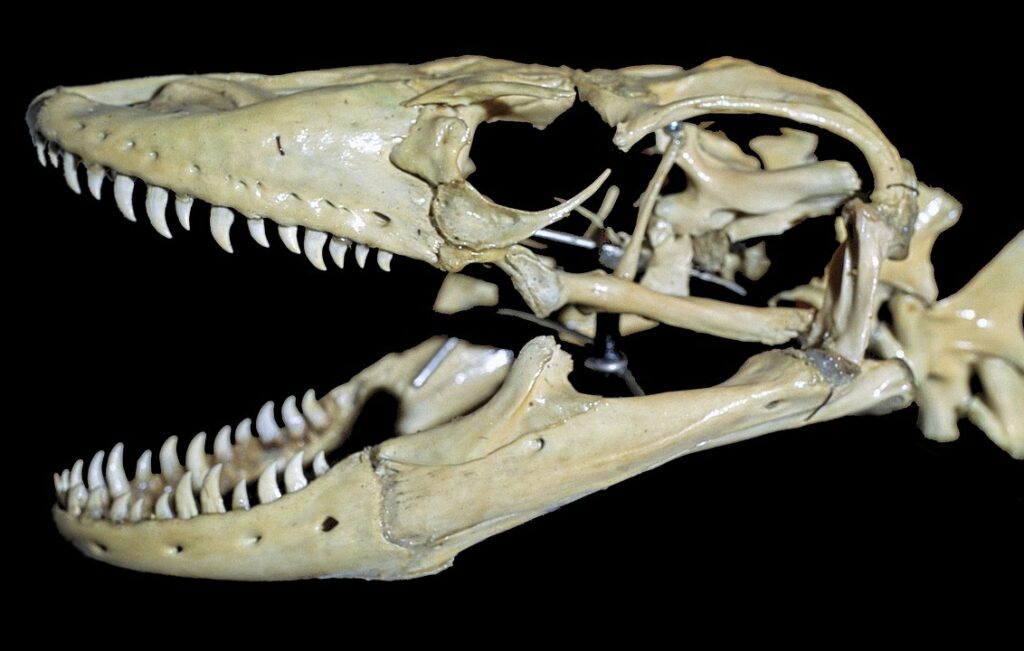
The shape of an animal’s teeth can tell us a lot about what kinds of food it ate. Researchers do this by comparing features of the tooth to modern animals. For example, many theropod (“meat-eating”) dinosaurs had ziphodont teeth. These are teeth characterized by a curved, blade shape and serrated on either side, like a steak knife. We see these types of teeth today in monitor lizards like the Komodo dragon, animals that use their teeth for ripping and tearing flesh. Since most theropods also had teeth like this, the best explanation is that they used their teeth for much the same purposes.
Teeth can also be a helpful dietary clue when we find them scattered around the bones of a prey animal, as sharks, crocodiles, and other carnivores often shed teeth throughout their lives whenever they bite into something hard.
Bite Marks
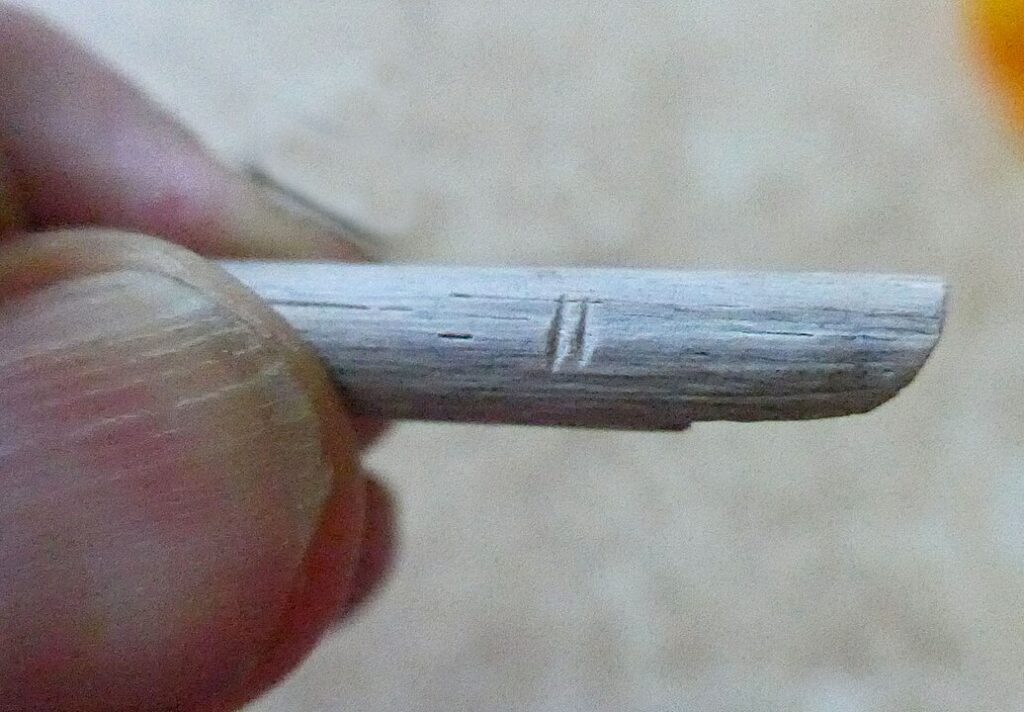
Many carnivores bite their food, either during the act of killing it or while they are attempting to rip it into bite-sized pieces. Sometimes, we find evidence for this on the bones of their prey. By comparing the size and shape of the bite marks to known carnivore teeth, scientists can estimate what animal may have left them behind. If we are especially fortunate, we find teeth from the carnivore itself lodged into whatever they were trying to eat!
Calcium Isotopes
Just as the shape of a dinosaur’s tooth can help us deduce what it ate, so can the minerals compose it. Vertebrates (animals with backbones) get almost all of their calcium from the food they eat. After measuring the proportion of calcium isotopes in a carnivorous vertebrate’s tooth enamel, scientists can compare them with the proportions of calcium isotopes of potential prey animals in their environment.
Gut Contents
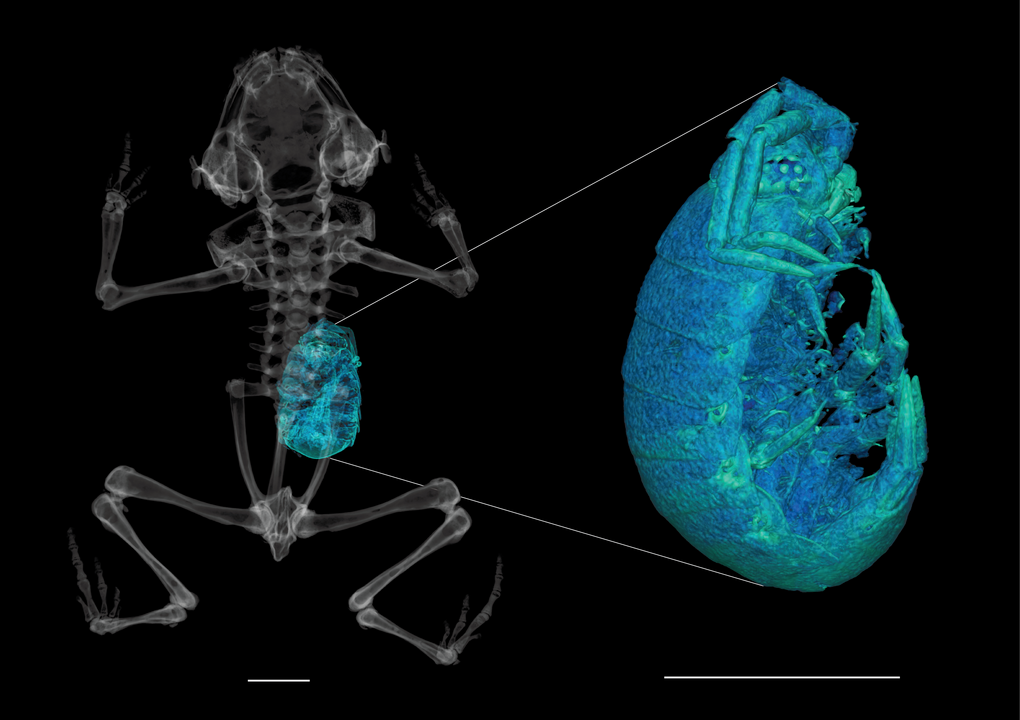
Sometimes, we find fossilized animals with their last meal in their stomachs. The length of time between consumption and death of the carnivore determines how well-preserved the stomach contents will be. An animal that died shortly before its last meal may have pristine bones–or sometimes even the whole animal–inside. Whereas if the carnivore died a while after having its last meal, the bones in its stomach will show evidence of etching from corrosive, digestive acids. Studying the stomach contents of long-dead animals can give us keen insight into what they ate when they were alive.
Coprolites
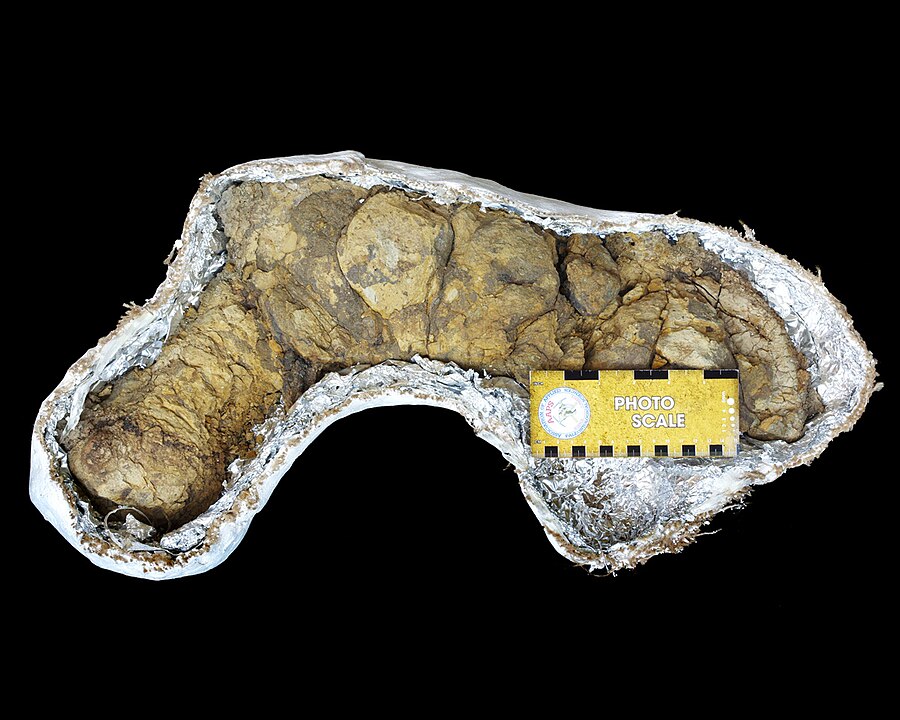
Everyone knows that whatever a creature does not digest in its stomach must come out the other end. Coprolite is the term scientists use for fossilized droppings. Whatever has survived stomach acids can be preserved inside of the droppings themselves, giving scientists a clue about what the ancient animal was eating. Findings such as bones can indicate the pooper was a carnivore.
Carnivory in the Fossil Record
Evidence for carnivory as presented above is plentiful throughout the fossil record. Let us explore a few startling examples below:
Cannibal Trilobites
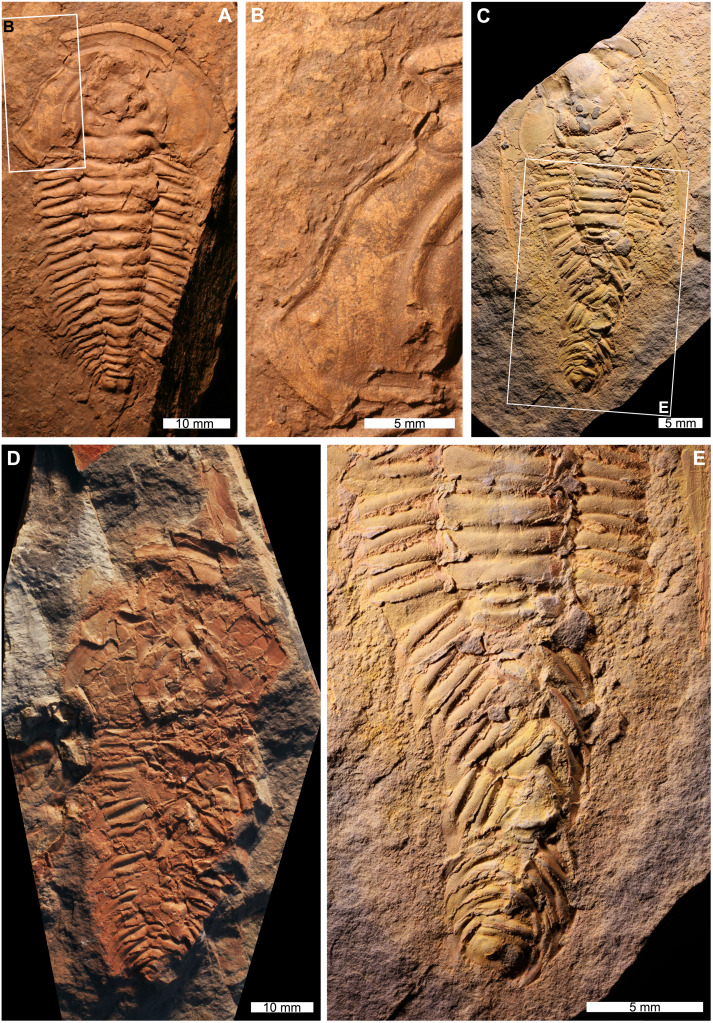
Redlichia is a genus of trilobite, a type of marine invertebrate resembling modern roly-polies. Fossils of Redlichia with healed injuries have been found in the Emu Bay Shale located on Kangaroo Island, South Australia. The nature of these injuries are consistent with a predator attack in the form of another Redlichia. But not all Redlichia survived these encounters. At the same site, scientists also find mangled Redlichia fossils, as well as coprolites containing digested chunks of their shells. These trilobites not only attacked members of their own genus, but ate them as well. This represents the earliest occurrence of cannibalism in the fossil record.1
Jaws versus Godzilla
Craddock Ranch of Baylor County, Texas is the site of a fossilized crime scene. Fossilized teeth from a sail-backed non-mammalian synapsid (“mammal-like reptile”) called Dimetrodon have been found scattered amongst the bones of small sharks called Xenacanthus. This strongly suggests that Dimetrodon were actively feeding on the sharks. But it went the other way too. Long, deeply-incised shark teeth bite marks have also been found on the bones of Dimetrodon as well. The shape of the marks suggest the sharks rolled themselves around as they tried to wrench flesh free from the carcasses they were eating.2
Two Fish and a Pterosaur
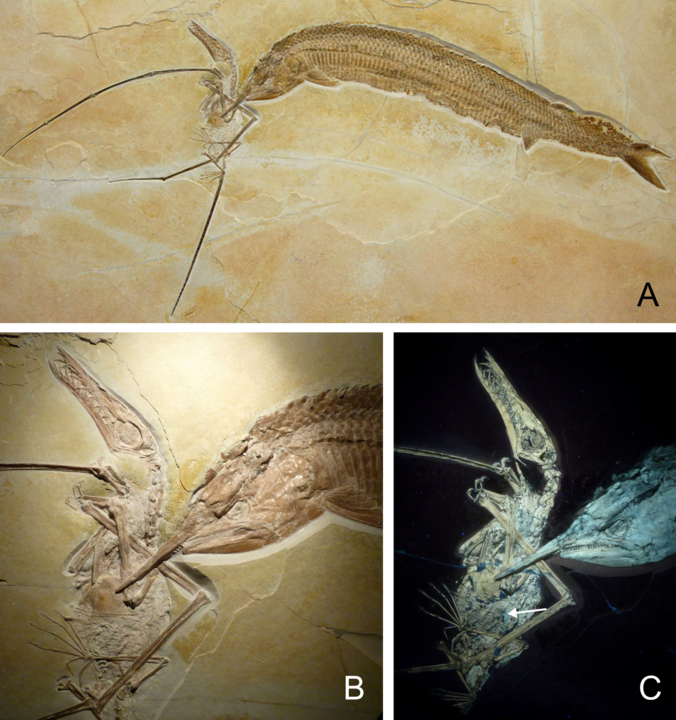
The Solnhofen Limestone in Germany hails a remarkable fossil of a long-tailed pterosaur (flying reptile) called Rhamphorynchus who got in too close with a fish called Aspidorhynchus. The fish’s jaws are snagged in the pterosaur’s wings. And as if this were not enough, there is a second fish, Leptolepides, in the pterosaur’s throat. Scientists think Rhamphorynchus dove into water after fish, like many seabirds do today. After catching and swallowing a Leptolepides, a larger fish attacked from below. Its sharp snout and teeth became ensnared in the pterosaur’s wing. Neither animal able to get free, the trio sank to the water bottom and died.3
Cooperating Carnivores
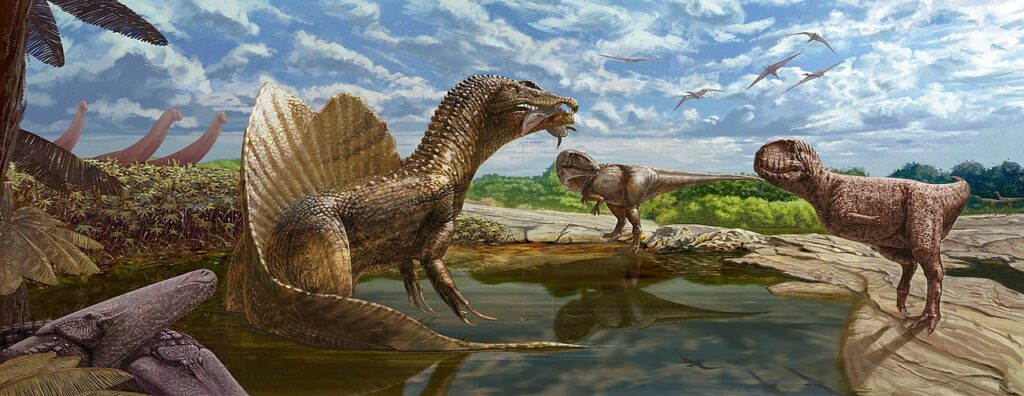
A recent study analyzed the calcium isotopes in the teeth of several fossilized carnivores found in a variety of fossil deposits across North Africa, including Niger and Morocco. By comparing these calcium isotope proportions to those of other animals buried alongside them, they discovered that not all of the carnivores were eating the same types of prey. Large carnivores (like Carcharodontosaurus) fed on large, herbivorous dinosaurs. Spinosaurs (such as Spinosaurus itself) primarily fed on fish. Meanwhile giant crocodile-like reptiles (such as Sarcosuchus) had a mixed diet of aquatic and terrestrial prey.4
Menace of the Gobi Desert
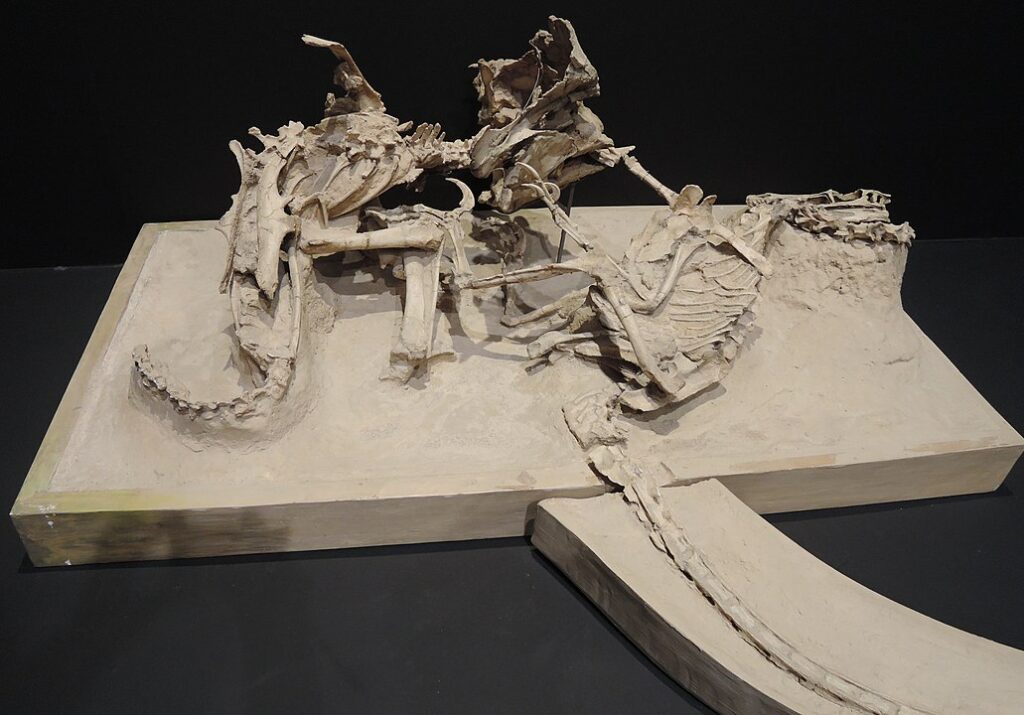
Though smaller than its Hollywood counterpart, the fossil record demonstrates that Velociraptor was every bit as tenacious. In the Gobi Desert of Mongolia, the fossil of this predator was clenching the fossil of a Protoceratops, a pig-sized relative of Triceratops.5 The Velociraptor’s sickle-shaped talon is jabbed where the Protoceratops’ neck would have been. Meanwhile the Protoceratops has its jaws locked on the Velociraptor’s arm. Paleontologists believe the animals were brawling before they died. They must have been buried quite rapidly in order to be preserved in such a realistic pose.
Another Velociraptor specimen was found with the long bone of a pterosaur in its stomach.6 Given the size of the bone, it probably came from a pterosaur too large for the Velociraptor to take down. This suggests that, like all predators, Velociraptor was not above scavenging when the opportunity presented itself.
King of the Tyrant Lizards
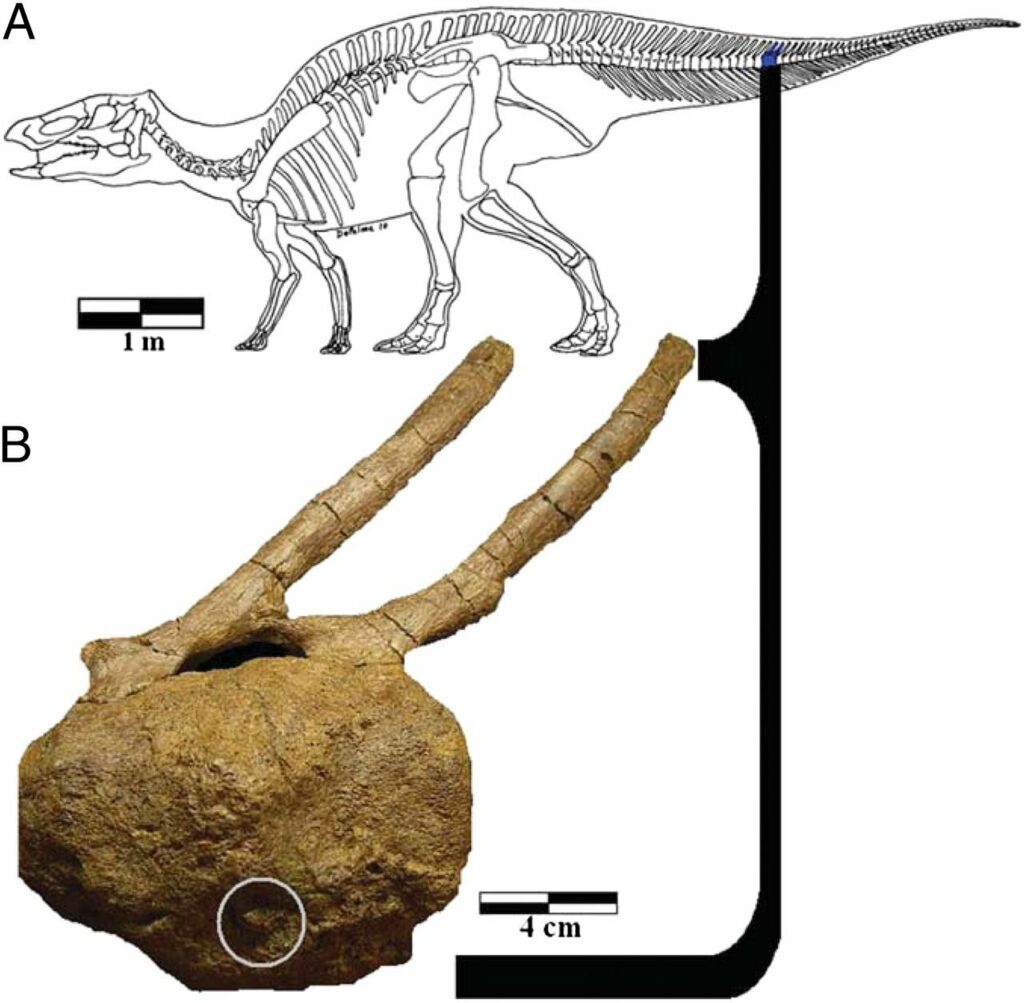
Most predatory dinosaurs had blade-shaped teeth for slicing meat. But Tyrannosaurus had teeth that were about the same size and shape of lethal bananas, and deeply rooted in the animal’s jaw. Backed up with powerful jaw muscles, Tyrannosaurus was best suited for pulverizing the flesh and bones of its prey with one bite. The tip of a Tyrannosaurus tooth was found embedded in the tail bones of a hadrosaur (duck-billed dinosaur). There is evidence of new bone growth surrounding the tooth, suggesting that this was not an act of scavenging. A live hadrosaur survived an attack from Tyrannosaurus long enough for the bite to begin healing.7
Additional evidence for Tyrannosaurus carnivorous habits comes from its droppings. A 17-inch long coprolite was discovered in southwestern Saskatchewan containing 30-50% bone fragments. The bones were fragmented because they were pulverized in the jaws of a Tyrannosaurus and are degraded from exposure to stomach acids.8
There’s Always a Bigger Fish
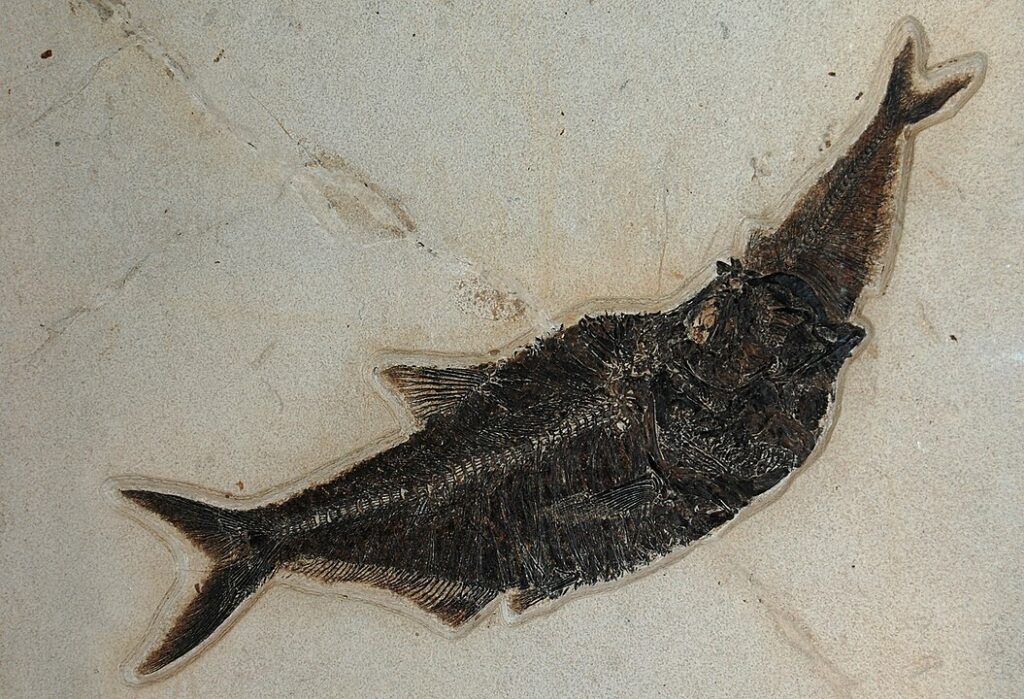
The Green River Formation in Wyoming, Utah, and Colorado contains lots of fossils belonging to many species of fish. Some of them are found in the process of swallowing their last meal. In this image, you can see Diplomystus swallowing a Knightia, a herring-like fish.
The Snake That Swallowed a Lizard that Swallowed a Beetle
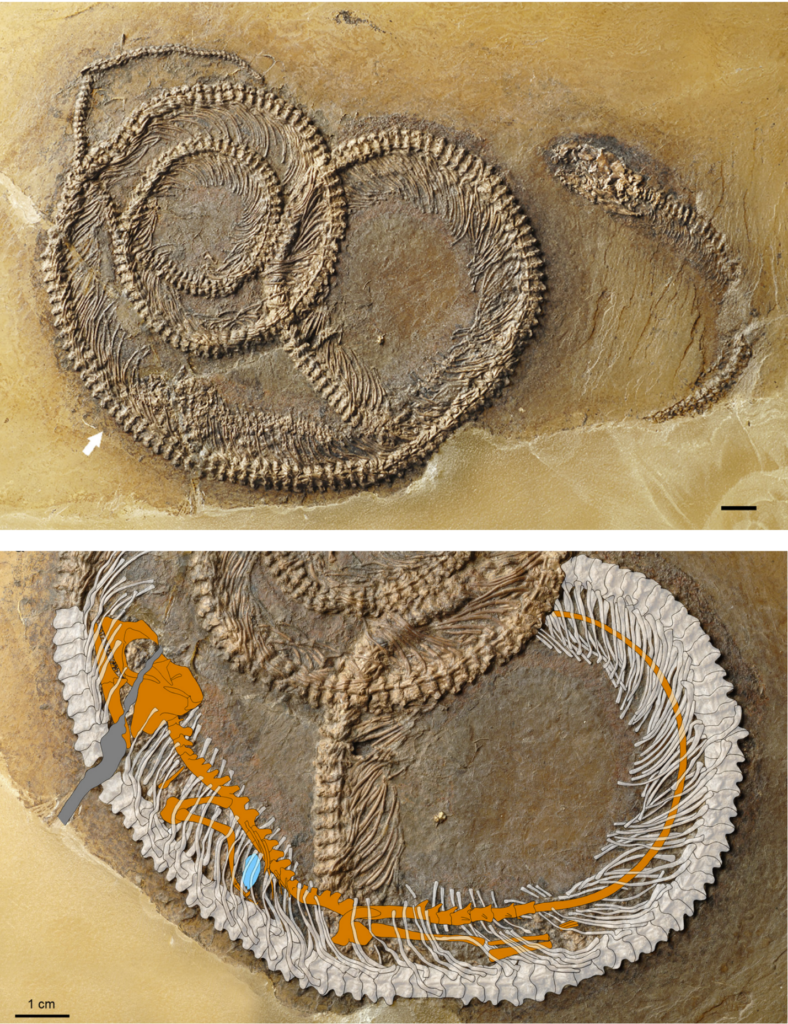
A fossil Palaeopython, an extinct relative of modern boa constrictors, has been found at the World Heritage site Messel Pit in Germany. In its stomach is preserved an extinct type of chameleon (Geiseltaliellus) as its last meal. But the fossilized food chain continues with the chameleon’s last meal as well: a beetle.9 The study did not report whether or not the beetle’s final dinner was also preserved.
Mega-Bite from a Mega-Shark
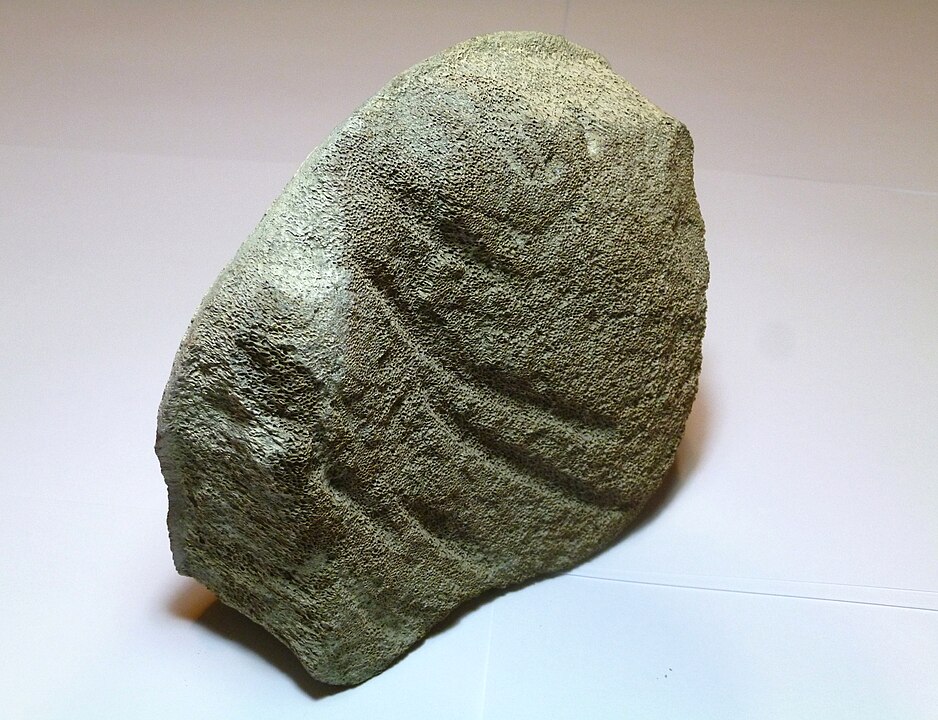
Estimated to measure over 50-60 feet in length, Otodus megalodon was the largest shark to ever exist.10 We know a lot about what it ate because we find fossils of other animals with bite marks from this beast in them.11 At the top of megalodon’s menu were marine mammals, especially baleen whales and seals.
Conclusion
As demonstrated above, there is evidence that carnivory has been in existence since the very beginning of the fossil record. To Christians, this should not be surprising. The Curse enacted upon the world as a result of humankind’s sin changed many aspects of Creation. Death, suffering, bloodshed, and carnivory could occur among man and beast. As such, so long as we have evidence of ancient animal life, we should expect to find evidence for the Fall, which would include carnivory. And this is exactly what we see.
The fossil record of carnivory is even more extensive than shown here. It is an illustrative reminder that carnivores have been a reality for a very long time. But we as Christians can take encouragement in the knowledge that just as there was once a time when carnivory did not exist, there will be a time in the future when it and all other manifestations of the Curse will be no more (Revelation 21:1-4).
Footnotes
- Bicknell, R. D., Holmes, J. D., Pates, S., García-Bellido, D. C., & Paterson, J. R. (2022). “Cambrian carnage: Trilobite predator-prey interactions in the Emu Bay Shale of South Australia.” Palaeogeography, Palaeoclimatology, Palaeoecology, 591, 110877. ↩︎
- Zoehfeld, K. W., Mossbrucker, M. T. Bakker, R. T., and Flis, C.J. (2014). “Dimetrodon Feeding on Sharks and Sharks Feeding on Dimetrodon: Texas Early Permian Food Webs Based on Aquatic Predation.” 2014 GSA Annual Meeting in Vancouver, British Columbia. ↩︎
- Frey, E., & Tischlinger, H. (2012). “The Late Jurassic pterosaur Rhamphorhynchus, a frequent victim of the ganoid fish Aspidorhynchus?”. PloS one, 7(3), e31945. ↩︎
- Hassler, A., Martin, J. E., Amiot, R., Tacail, T., Godet, F. A., Allain, R., & Balter, V. (2018). “Calcium isotopes offer clues on resource partitioning among Cretaceous predatory dinosaurs.” Proceedings of the Royal Society B: Biological Sciences, 285(1876), 20180197. ↩︎
- Barsbold, Rinchen (1983). “Carnivorous dinosaurs from the Cretaceous of Mongolia.” Transactions of the Joint Soviet-Mongolian Paleontological Expedition (in Russian). 19: 5–119. ↩︎
- Hone, D., Tsuihiji, T., Watabe, M., & Tsogtbaatr, K. (2012). “Pterosaurs as a food source for small dromaeosaurs.” Palaeogeography, Palaeoclimatology, Palaeoecology, 331, 27-30. ↩︎
- DePalma, R. A., Burnham, D. A., Martin, L. D., Rothschild, B. M., & Larson, P. L. (2013). “Physical evidence of predatory behavior in Tyrannosaurus rex.” Proceedings of the National Academy of Sciences, 110(31), 12560-12564. ↩︎
- Chin, K., Tokaryk, T. T., Erickson, G. M., & Calk, L. C. (1998). “A king-sized theropod coprolite.” Nature, 393(6686), 680-682. ↩︎
- Smith, K. T., & Scanferla, A. (2016). “Fossil snake preserving three trophic levels and evidence for an ontogenetic dietary shift.” Palaeobiodiversity and Palaeoenvironments, 96, 589-599. ↩︎
- Shimada, K., Maisch IV, H. M., Perez, V. J., Becker, M. A., & Griffiths, M. L. (2023). “Revisiting body size trends and nursery areas of the Neogene megatooth shark, Otodus megalodon (Lamniformes: Otodontidae), reveals Bergmann’s rule possibly enhanced its gigantism in cooler waters.” Historical Biology, 35(2), 208-217. ↩︎
- Collareta, Alberto, Olivier Lambert, Walter Landini, Claudio Di Celma, Elisa Malinverno, Rafael Varas-Malca, Mario Urbina, and Giovanni Bianucci. (2017) “Did the giant extinct shark Carcharocles megalodon target small prey? Bite marks on marine mammal remains from the late Miocene of Peru.” Palaeogeography, Palaeoclimatology, Palaeoecology 469: 84-91. ↩︎

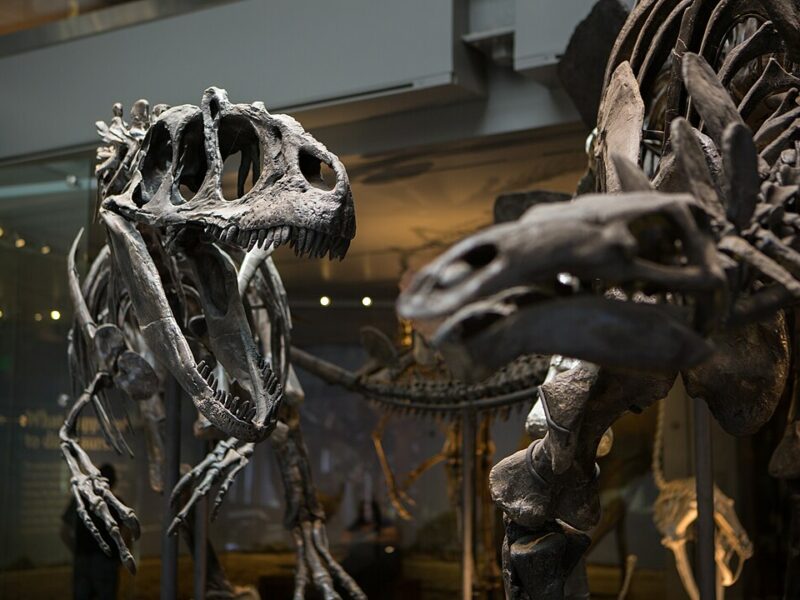





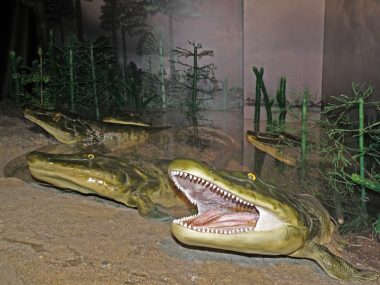




yes it was only after the fall creatures killed each other. thats why morphing happened everywhere after the fall. The so called dinosaurs, flightless birds for me or other creatures but not reptiles, would have big teeth.
no mammals are found below the k-t line, the flood year, because they did not exist in those bodyplans we have today. Yet all creatures either killed or killed to avoid being killed or ran and hide.
Christian, thank you so much for this article.
Here is maybe another interesting fossil specimen which might show the canivory because Hybodus hauffianus (a shark) is known to have fed on belemnites.
https://doi.org/10.1186/s13358-021-00225-z
And could you please write (an) article(s) on how the science textbooks in the United States or any other countries describe numerical ages of the Earth, rocks, fossils, etc. etc. under the long-age paradigm?
Bless you and New Creaton ministry in the name of Yeshua-:)